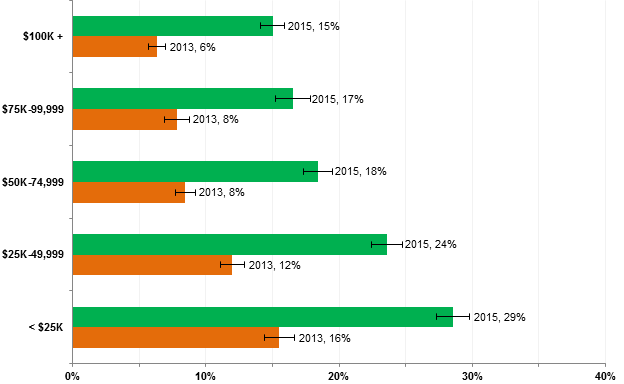As "wireless substitution" gutted the fixed network voice business, there now are growing signs that mobile has become an effective substitute for fixed network Internet access.
“Mobile Internet service appears to be competing more directly with wired Internet connections,” says Giulia McHenry, National Telecommunications and Information Administration chief economist.
Between 2013 and 2015, “the proportion of online households that relied exclusively on mobile service at home doubled between 2013 and 2015, from 10 percent to 20 percent,” she says.
About 75 percent of U.S households using the Internet at home in 2015 still used wired technologies for high-speed Internet service, including cable TV high speed access, digital subscriber line and optical fiber connections, she notes.
But that represents a sizable drop in fixed network home Internet access use, from 82 percent of online households in July 2013 to 75 percent two years later.
Percent of Households Using the Internet at Home, 2013-2015
As is the case in many other regions globally, low-income households are significantly more likely to depend on a mobile data plan than those with higher incomes.
For example, 29 percent of online households with family incomes below $25,000 only used mobile Internet service at home, compared with 15 percent of those households with incomes of $100,000 or more.
Exclusive Use of Mobile Internet Service 
Also, NTIA’s latest data shows that some of the demographic groups that have historically lagged behind in using the Internet—senior citizens, minorities, and Americans with lower levels of educational attainment—are erasing the gaps.
Internet use increased significantly among children and older Americans between 2013 and 205, for example.
Children between the ages of three and 14 became substantially more likely to go online, as Internet use among this group increased from 56 percent in 2013 to 66 percent in 2015.
While Internet use among those Americans with at least some post-secondary education remained steady between 2013 and 2015, it increased significantly among those with education up to a high school diploma.
Although those with lower levels of educational attainment are gradually increasing their online presence, the gap in Internet use based on education remains quite large, with 88 percent of college graduates going online in 2015, compared with 58 percent of those with no high school diploma.
Internet use among those aged 65 or older increased from 51 percent to 56 percent during the same period.
Usage remained largely unchanged among those who were previously most likely to go online, with 83 percent of Americans between the ages of 25 and 44 reporting Internet use in both 2013 and 2015.

No comments:
Post a Comment